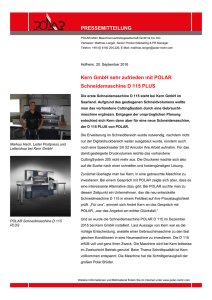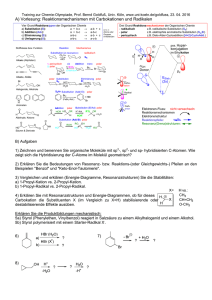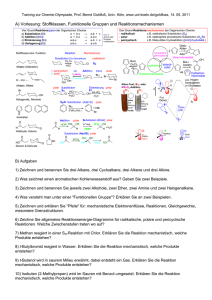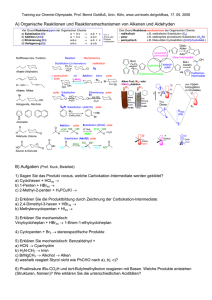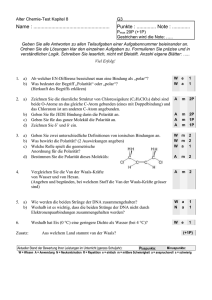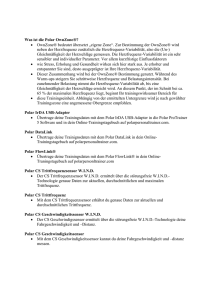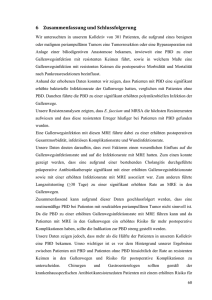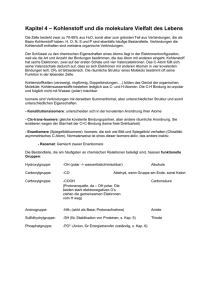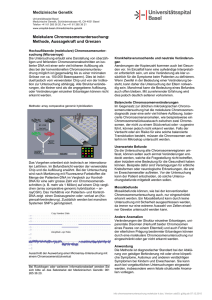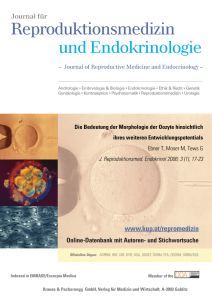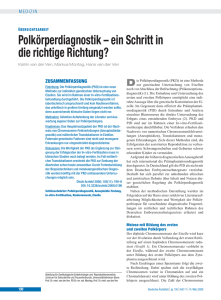referiert - Deutsches Ärzteblatt
Werbung
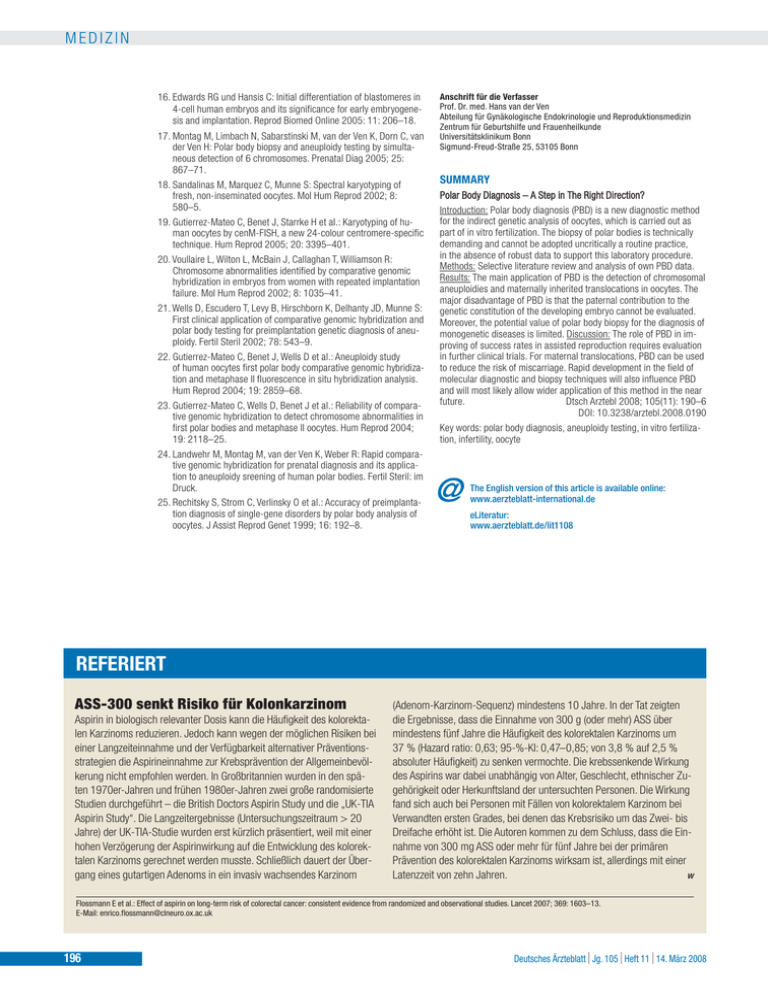
MEDIZIN 16. Edwards RG und Hansis C: Initial differentiation of blastomeres in 4-cell human embryos and its significance for early embryogenesis and implantation. Reprod Biomed Online 2005: 11: 206–18. 17. Montag M, Limbach N, Sabarstinski M, van der Ven K, Dorn C, van der Ven H: Polar body biopsy and aneuploidy testing by simultaneous detection of 6 chromosomes. Prenatal Diag 2005; 25: 867–71. 18. Sandalinas M, Marquez C, Munne S: Spectral karyotyping of fresh, non-inseminated oocytes. Mol Hum Reprod 2002; 8: 580–5. 19. Gutierrez-Mateo C, Benet J, Starrke H et al.: Karyotyping of human oocytes by cenM-FISH, a new 24-colour centromere-specific technique. Hum Reprod 2005; 20: 3395–401. 20. Voullaire L, Wilton L, McBain J, Callaghan T, Williamson R: Chromosome abnormalities identified by comparative genomic hybridization in embryos from women with repeated implantation failure. Mol Hum Reprod 2002; 8: 1035–41. 21. Wells D, Escudero T, Levy B, Hirschborn K, Delhanty JD, Munne S: First clinical application of comparative genomic hybridization and polar body testing for preimplantation genetic diagnosis of aneuploidy. Fertil Steril 2002; 78: 543–9. 22. Gutierrez-Mateo C, Benet J, Wells D et al.: Aneuploidy study of human oocytes first polar body comparative genomic hybridization and metaphase II fluorescence in situ hybridization analysis. Hum Reprod 2004; 19: 2859–68. 23. Gutierrez-Mateo C, Wells D, Benet J et al.: Reliability of comparative genomic hybridization to detect chromosome abnormalities in first polar bodies and metaphase II oocytes. Hum Reprod 2004; 19: 2118–25. 24. Landwehr M, Montag M, van der Ven K, Weber R: Rapid comparative genomic hybridization for prenatal diagnosis and its application to aneuploidy sreening of human polar bodies. Fertil Steril: im Druck. 25. Rechitsky S, Strom C, Verlinsky O et al.: Accuracy of preimplantation diagnosis of single-gene disorders by polar body analysis of oocytes. J Assist Reprod Genet 1999; 16: 192–8. Anschrift für die Verfasser Prof. Dr. med. Hans van der Ven Abteilung für Gynäkologische Endokrinologie und Reproduktionsmedizin Zentrum für Geburtshilfe und Frauenheilkunde Universitätsklinikum Bonn Sigmund-Freud-Straße 25, 53105 Bonn SUMMARY Polar Body Diagnosis – A Step in The Right Direction? Introduction: Polar body diagnosis (PBD) is a new diagnostic method for the indirect genetic analysis of oocytes, which is carried out as part of in vitro fertilization. The biopsy of polar bodies is technically demanding and cannot be adopted uncritically a routine practice, in the absence of robust data to support this laboratory procedure. Methods: Selective literature review and analysis of own PBD data. Results: The main application of PBD is the detection of chromosomal aneuploidies and maternally inherited translocations in oocytes. The major disadvantage of PBD is that the paternal contribution to the genetic constitution of the developing embryo cannot be evaluated. Moreover, the potential value of polar body biopsy for the diagnosis of monogenetic diseases is limited. Discussion: The role of PBD in improving of success rates in assisted reproduction requires evaluation in further clinical trials. For maternal translocations, PBD can be used to reduce the risk of miscarriage. Rapid development in the field of molecular diagnostic and biopsy techniques will also influence PBD and will most likely allow wider application of this method in the near future. Dtsch Arztebl 2008; 105(11): 190–6 DOI: 10.3238/arztebl.2008.0190 Key words: polar body diagnosis, aneuploidy testing, in vitro fertilization, infertility, oocyte @ The English version of this article is available online: www.aerzteblatt-international.de eLiteratur: www.aerzteblatt.de/lit1108 REFERIERT ASS-300 senkt Risiko für Kolonkarzinom Aspirin in biologisch relevanter Dosis kann die Häufigkeit des kolorektalen Karzinoms reduzieren. Jedoch kann wegen der möglichen Risiken bei einer Langzeiteinnahme und der Verfügbarkeit alternativer Präventionsstrategien die Aspirineinnahme zur Krebsprävention der Allgemeinbevölkerung nicht empfohlen werden. In Großbritannien wurden in den späten 1970er-Jahren und frühen 1980er-Jahren zwei große randomisierte Studien durchgeführt – die British Doctors Aspirin Study und die „UK-TIA Aspirin Study“. Die Langzeitergebnisse (Untersuchungszeitraum > 20 Jahre) der UK-TIA-Studie wurden erst kürzlich präsentiert, weil mit einer hohen Verzögerung der Aspirinwirkung auf die Entwicklung des kolorektalen Karzinoms gerechnet werden musste. Schließlich dauert der Übergang eines gutartigen Adenoms in ein invasiv wachsendes Karzinom (Adenom-Karzinom-Sequenz) mindestens 10 Jahre. In der Tat zeigten die Ergebnisse, dass die Einnahme von 300 g (oder mehr) ASS über mindestens fünf Jahre die Häufigkeit des kolorektalen Karzinoms um 37 % (Hazard ratio: 0,63; 95-%-KI: 0,47–0,85; von 3,8 % auf 2,5 % absoluter Häufigkeit) zu senken vermochte. Die krebssenkende Wirkung des Aspirins war dabei unabhängig von Alter, Geschlecht, ethnischer Zugehörigkeit oder Herkunftsland der untersuchten Personen. Die Wirkung fand sich auch bei Personen mit Fällen von kolorektalem Karzinom bei Verwandten ersten Grades, bei denen das Krebsrisiko um das Zwei- bis Dreifache erhöht ist. Die Autoren kommen zu dem Schluss, dass die Einnahme von 300 mg ASS oder mehr für fünf Jahre bei der primären Prävention des kolorektalen Karzinoms wirksam ist, allerdings mit einer w Latenzzeit von zehn Jahren. Flossmann E et al.: Effect of aspirin on long-term risk of colorectal cancer: consistent evidence from randomized and observational studies. Lancet 2007; 369: 1603–13. E-Mail: [email protected] 196 Jg. 105 Heft 11 14. März 2008 Deutsches Ärzteblatt
